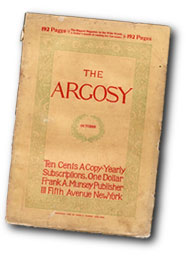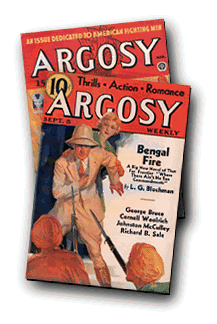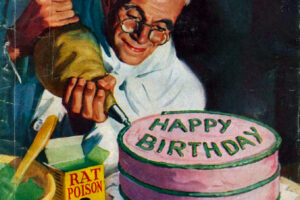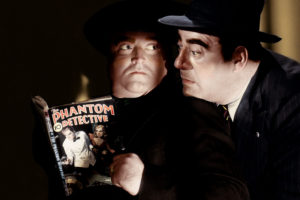— Frank Munsey
Frank Munsey turned those words into action when he revamped Argosy in the 1890s and transformed American magazine publishing for the next 50 years.

Beginning with the October 1896 issue, Argosy became an all-fiction magazine.
Munsey’s new Argosy introduced American readers to the “pulp” magazine, so named because the inexpensive paper it was printed on was made from pulpwood scraps.
The pulps grew into their own over the next 35 years. Though their content dealt mainly with “spicy” love stories, detective, western and war fiction, the magazines did produce a few shining stars. It was during these years that Edgar Rice Burroughs introduced his two most famous characters, Tarzan and John Carter of Mars.
Hugo Gernsback’s Amazing Stories introduced “science fiction” to readers. And pulps introduced readers to H.P. Lovecraft, Dashiell Hammett, Talbot Mundy, Robert E. Howard and E.E. “Doc” Smith, among scores of other authors.
Then in 1931, Street and Smith Publications offered readers a completely new type of pulp called the “character magazine.” The first character to appear in his own magazine became the most famous of these pulp characters — The Shadow.
The first issue of The Shadow, A Detective Magazine sold out within days of its initial release and became an instant hit with readers. Publishers scrambled to match its success.
Street and Smith followed with a second hit, Doc Savage. From there, the character pulp blossomed with the likes of The Spider, G–8 and His Battle Aces, The Avenger and Operator 5.

Other characters — The Ghost, The Black Bat, The Whisperer, Captain Hazzard, The Masked Detective and Captain Zero — were basically rip–offs of the successful magazines. Most of these characters lasted but a few issues in their own magazines and a while longer as back–up stories in more popular character magazines.
The pulps remained popular until World War II, when most fell victim to the wartime paper shortage which cut the amount of paper available for “nonessential” publications. A few of the magazines, including The Shadow, lasted through the war until their popularity diminished with the introduction of television and they were canceled.
Pulps still exist today, but in the more familiar form of the paperback book and the digest magazine. (For example, Analog magazine was originally the pulp Astounding Science Fiction.)
More than one hundred years after Frank Munsey introduced the pulp magazine,
the ideal is still around and interest in pulp–magazine stories continues.
A version of this article first appeared in The Reflector, Mississippi State University’s student newspaper, Sept. 18, 1979.
Copyright 1979, 1996 William Lampkin and Charles Corder



